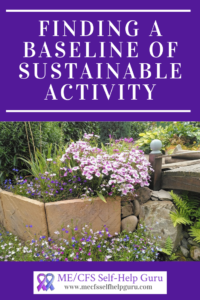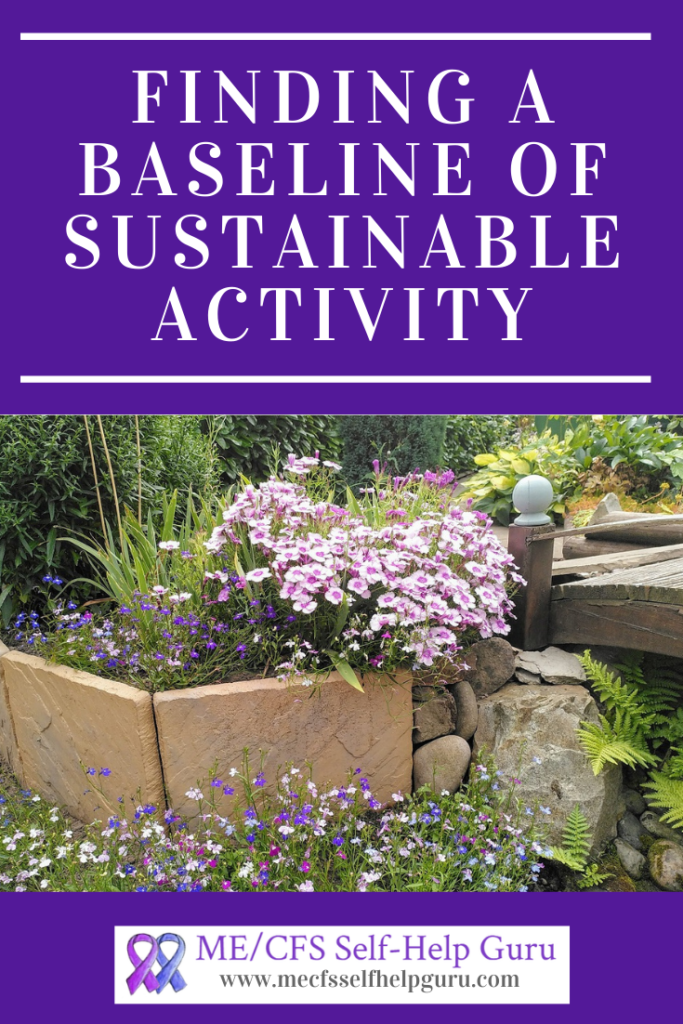Finding a baseline of sustainable activity is an important strategy for learning how to live within your ‘energy envelope’. Making sure that we only use the energy that is easily available to us is the most reliable way of stabilising our condition. Saving some of that energy for the body to work on healing can also help bring about substantial improvements. I believe I regained my full health after my first bout of this illness mainly because I learned how not to use too much energy. Take all the pressures you can off your struggling bodily systems and hopefully, your body will eventually find its balance again.
Living within your energy envelope isn’t that easy though. Our energy levels change on a day-to-day basis. Our worries, desires and emotions can all get in the way of our awareness of our energy level or our willingness to respond to that awareness. We need strategies. Pacing is a strategy that involves finding a baseline of ‘symptom free’ or ‘sustainable’ activity and then breaking the activity periods within that normal activity range into smaller parcels with more frequent rests. The idea is that once you have learned to pace at your baseline you will be able to gradually increase activity little by little. For me pacing also means listening and responding to your body’s changing energy level. If you can work out what you can do on an average day without making yourself worse, on a better day you can perhaps do a little bit more and you can prioritise more rest on a not-so-good day.
Sustainable vs Symptom-Free Baseline
For many sufferers of ME/CFS finding a symptom free baseline of activity is just unrealistic. Rest alone does not cure this illness and will not rid you of all your symptoms. Take lactic acid muscle pain. I believe that it isn’t just caused by actively doing too much, but it’s also caused by the nervous system not switching the muscles off. Even at rest, many people with ME/CFS are not able to easily relax their muscles. Under-activity of the parasympathetic nervous system can mean that the message to let go just doesn’t get through. If you constantly suffer from stiff and sore muscles resting may not be enough to reduce this symptom. Practices that moderate the autonomic nervous system might be more effective at minimising muscle pain than the frustration involved in total rest.
Another symptom that might not respond sufficiently to rest is the flu like pain that may result from a high level of cytokines produced by an inappropriate immune response. Whilst rest might give the immune system a bit of a boost, a healthy diet, some gentle circulation-promoting movement and a regular body-clock-setting routine may offer more to a disrupted immune system than simple rest.
Instead of aiming for symptom free, I think it is far more important to aim for sustainability. What can you do without making yourself worse? And how can you include activities that might help get you better?
One way of exploring your baseline of sustainable activity is to record your daily activity level hour by hour (including intensity of effort for each activity) over a period of a couple of weeks, at the same time as monitoring your energy level. The aim would be to cut down your activity level to match those days when your energy level didn’t drop much over the day or from one day to the next.
Exhaustion and Exertion
One symptom that we maybe should aim to eradicate when looking for our sustainable baseline is exhaustion. As most of us wake up feeling pretty exhausted, this is a difficult one to call. The exhaustion I aim to avoid is that feeling of not being able to do something without a sense of exertion. I can feel tired, groggy and lethargic most of the time, but I know that if I move around gently (or employ my mind) in a relaxed, effortless manner I don’t get any worse. My body tells me it has no energy left when I have to make a real effort to do something. For me, a sustainable baseline of activity is one that can be achieved without exertion.
I also have a theory that for some of us our exhaustion can sometimes be mistaken for the inertia caused by low blood pressure. I find that, particularly mid-afternoon, I might feel exhausted but if I get up and do some very gentle movement that gets my circulation flowing, I soon feel a lot better (with a resulting increase of about 5 points on my blood pressure). If you want to test this out remember that you might have to make a mental effort to get yourself going but the gentle movement should always be effortless.
 Balancing Mental Health Needs
Balancing Mental Health Needs
Sometimes after months of trying to get on with your life despite this illness you might find that your baseline of sustainable activity is way lower that you think you can cope with. Remember that if you continue to push your body you could end up getting worse and worse progressively lowering the level to which you potentially might recover. That said, depression won’t help either so it’s really important that your baseline of activity sustains your mental health too. If the things that normally make you happy are way beyond your baseline, then you might have to find new ways of being happy. I explore this massive challenge in many of my other posts. If there are things that make you happy that are just beyond your baseline, then from time to time you could plan to do them. But make sure you plan very restful (below baseline) days before and after.
Edited and updated 01/08/21








This is a wonderful article. Thank you for posting. I was forgetting about my baseline and always going over it causing a crash.
Nice article! I have found that when I do make a point to live within my “energy envelope” I seem to have more energy to draw from because I’m more aware of what my boundaries are and am better at pacing myself.
Exactly Sandy! Wishing you more and more energy as you get better and better at staying within your energy envelope!